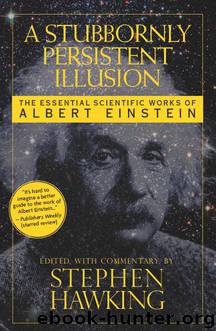A Stubbornly Persistent Illusion by Stephen Hawking

Author:Stephen Hawking
Language: eng
Format: epub, mobi
ISBN: 9780762439225
Publisher: Running Press
Selections from
The Meaning of Relativity
Three hundred years before Einstein, Galileo Galilei developed a theory of relativity that ultimately formed one of the pillars of Sir Isaac Newton’s mechanics. In The Meaning of Relativity, Einstein presents Galilean relativity as a precursor not only to Newton’s work, but to his own as well.
Galilean relativity is based on the simple and intuitive idea that time flows constantly for all observers regardless of their state of motion. Galileo thus anticipated Newton’s first law of motion: objects in motion will maintain a constant speed and direction unless acted upon by an outside force.
For all of the apparent mathematical complexity in The Meaning of Relativity, Einstein’s goals are quite modest. He is simply demonstrating that measurements on either stationary or moving frames will both yield results that satisfy Newton’s laws of motion. He proceeds to show at the end of the chapter that a different set of transformations, those suggested by Hendrik Lorentz, are required to make Maxwell’s equations of electricity and magnetism work in moving frames of reference.
The difference between Galileo’s transformations and those of Lorentz is that the former result in a constant flow of time for all observers, while the latter yield different rates of time for observers in different states of motion.
But what do we mean by a “constant flow of time”? It is simple to say that one event precedes another, or that they occur simultaneously, but how do we measure time, except through time itself? Einstein suggests using the reflection of an emitted light beam as a clock, postulating that light travels at the same speed regardless of the state of motion of an observer. This simple thought experiment yields some very surprising results.
For example, he finds that an observer measuring the events in a train moving past him will see its inhabitants moving slowly: a slowed heartbeat, a slowed wall-clock, and all other times slowed as well. Likewise, the person on the train thinks of himself as completely normal, but sees the clock at the train station running slowly. But because light must always travel at a constant speed, if time is related to the speed of travel, then lengths along the direction of motion must be related as well. In everyday life, these effects are not evident, only becoming manifest when the speeds involved approach that of light. Thus, at normal speeds, Einstein and Galileo’s relativity behave exactly the same.
In this work, Einstein argues effectively that although virtually all of our experiences suggest that Galileo and Newton were correct, unification of different branches of physics demand a new theory: special relativity.
Download
A Stubbornly Persistent Illusion by Stephen Hawking.mobi
This site does not store any files on its server. We only index and link to content provided by other sites. Please contact the content providers to delete copyright contents if any and email us, we'll remove relevant links or contents immediately.
The Complete Stick Figure Physics Tutorials by Allen Sarah(7135)
Secrets of Antigravity Propulsion: Tesla, UFOs, and Classified Aerospace Technology by Ph.D. Paul A. Laviolette(4974)
Thing Explainer by Randall Munroe(3782)
The River of Consciousness by Oliver Sacks(3414)
The Order of Time by Carlo Rovelli(3072)
How To by Randall Munroe(2911)
I Live in the Future & Here's How It Works by Nick Bilton(2840)
A Brief History of Time by Stephen Hawking(2819)
What If?: Serious Scientific Answers to Absurd Hypothetical Questions by Randall Munroe(2542)
The Great Unknown by Marcus du Sautoy(2532)
Midnight in Chernobyl by Adam Higginbotham(2386)
Blockchain: Ultimate Step By Step Guide To Understanding Blockchain Technology, Bitcoin Creation, and the future of Money (Novice to Expert) by Keizer Söze(2379)
Networks: An Introduction by Newman Mark(2264)
The Meaning of it All by Richard Feynman(2213)
Easy Electronics by Charles Platt(2205)
The Tao of Physics by Fritjof Capra(2163)
Midnight in Chernobyl: The Untold Story of the World's Greatest Nuclear Disaster by Adam Higginbotham(2075)
When by Daniel H Pink(2020)
Introducing Relativity by Bruce Bassett(2018)
